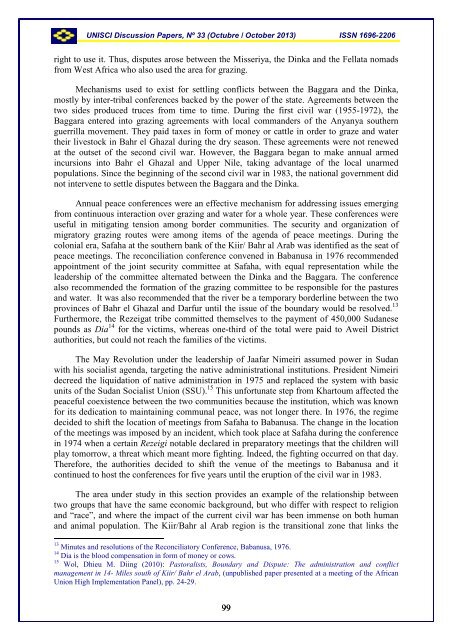UNISCI - Universidad Complutense de Madrid
UNISCI - Universidad Complutense de Madrid
UNISCI - Universidad Complutense de Madrid
You also want an ePaper? Increase the reach of your titles
YUMPU automatically turns print PDFs into web optimized ePapers that Google loves.
<strong>UNISCI</strong> Discussion Papers, Nº 33 (Octubre / October 2013) ISSN 1696-2206right to use it. Thus, disputes arose between the Misseriya, the Dinka and the Fellata nomadsfrom West Africa who also used the area for grazing.Mechanisms used to exist for settling conflicts between the Baggara and the Dinka,mostly by inter-tribal conferences backed by the power of the state. Agreements between thetwo si<strong>de</strong>s produced truces from time to time. During the first civil war (1955-1972), theBaggara entered into grazing agreements with local comman<strong>de</strong>rs of the Anyanya southernguerrilla movement. They paid taxes in form of money or cattle in or<strong>de</strong>r to graze and watertheir livestock in Bahr el Ghazal during the dry season. These agreements were not renewedat the outset of the second civil war. However, the Baggara began to make annual armedincursions into Bahr el Ghazal and Upper Nile, taking advantage of the local unarmedpopulations. Since the beginning of the second civil war in 1983, the national government didnot intervene to settle disputes between the Baggara and the Dinka.Annual peace conferences were an effective mechanism for addressing issues emergingfrom continuous interaction over grazing and water for a whole year. These conferences wereuseful in mitigating tension among bor<strong>de</strong>r communities. The security and organization ofmigratory grazing routes were among items of the agenda of peace meetings. During thecolonial era, Safaha at the southern bank of the Kiir/ Bahr al Arab was i<strong>de</strong>ntified as the seat ofpeace meetings. The reconciliation conference convened in Babanusa in 1976 recommen<strong>de</strong>dappointment of the joint security committee at Safaha, with equal representation while thelea<strong>de</strong>rship of the committee alternated between the Dinka and the Baggara. The conferencealso recommen<strong>de</strong>d the formation of the grazing committee to be responsible for the pasturesand water. It was also recommen<strong>de</strong>d that the river be a temporary bor<strong>de</strong>rline between the twoprovinces of Bahr el Ghazal and Darfur until the issue of the boundary would be resolved. 13Furthermore, the Rezeigat tribe committed themselves to the payment of 450,000 Sudanesepounds as Dia 14 for the victims, whereas one-third of the total were paid to Aweil Districtauthorities, but could not reach the families of the victims.The May Revolution un<strong>de</strong>r the lea<strong>de</strong>rship of Jaafar Nimeiri assumed power in Sudanwith his socialist agenda, targeting the native administrational institutions. Presi<strong>de</strong>nt Nimeiri<strong>de</strong>creed the liquidation of native administration in 1975 and replaced the system with basicunits of the Sudan Socialist Union (SSU). 15 This unfortunate step from Khartoum affected thepeaceful coexistence between the two communities because the institution, which was knownfor its <strong>de</strong>dication to maintaining communal peace, was not longer there. In 1976, the regime<strong>de</strong>ci<strong>de</strong>d to shift the location of meetings from Safaha to Babanusa. The change in the locationof the meetings was imposed by an inci<strong>de</strong>nt, which took place at Safaha during the conferencein 1974 when a certain Rezeigi notable <strong>de</strong>clared in preparatory meetings that the children willplay tomorrow, a threat which meant more fighting. In<strong>de</strong>ed, the fighting occurred on that day.Therefore, the authorities <strong>de</strong>ci<strong>de</strong>d to shift the venue of the meetings to Babanusa and itcontinued to host the conferences for five years until the eruption of the civil war in 1983.The area un<strong>de</strong>r study in this section provi<strong>de</strong>s an example of the relationship betweentwo groups that have the same economic background, but who differ with respect to religionand “race”, and where the impact of the current civil war has been immense on both humanand animal population. The Kiir/Bahr al Arab region is the transitional zone that links the13 Minutes and resolutions of the Reconciliatory Conference, Babanusa, 1976.14 Dia is the blood compensation in form of money or cows.15 Wol, Dhieu M. Diing (2010): Pastoralists, Boundary and Dispute: The administration and conflictmanagement in 14- Miles south of Kiir/ Bahr el Arab, (unpublished paper presented at a meeting of the AfricanUnion High Implementation Panel), pp. 24-29.99
















